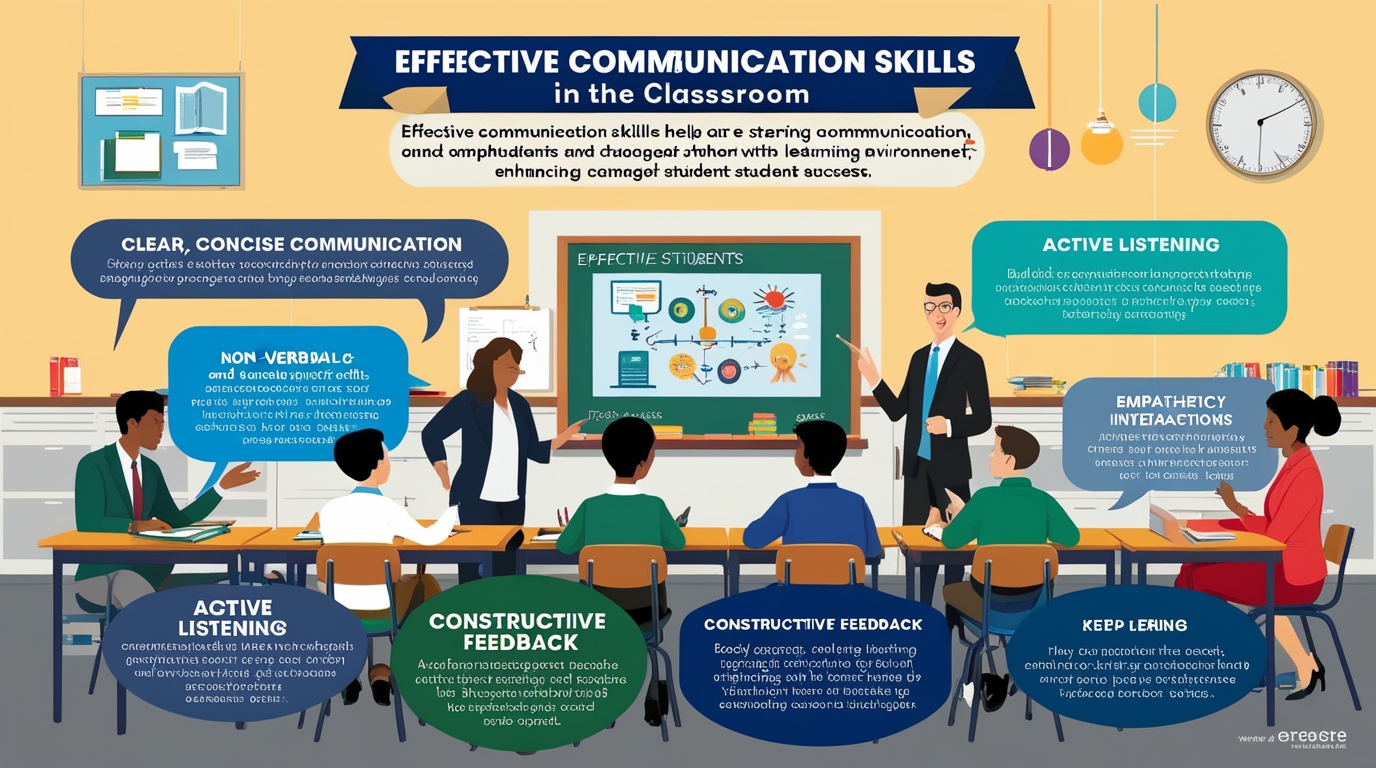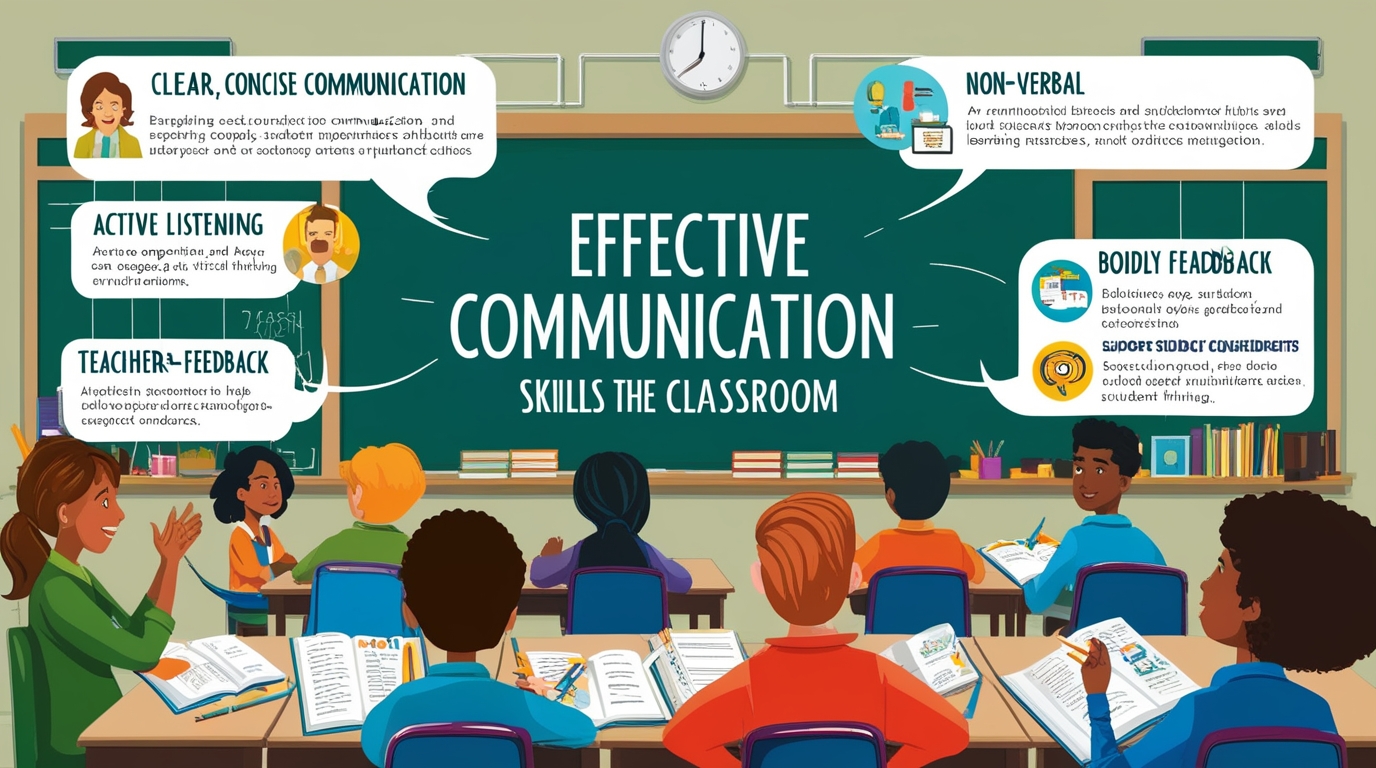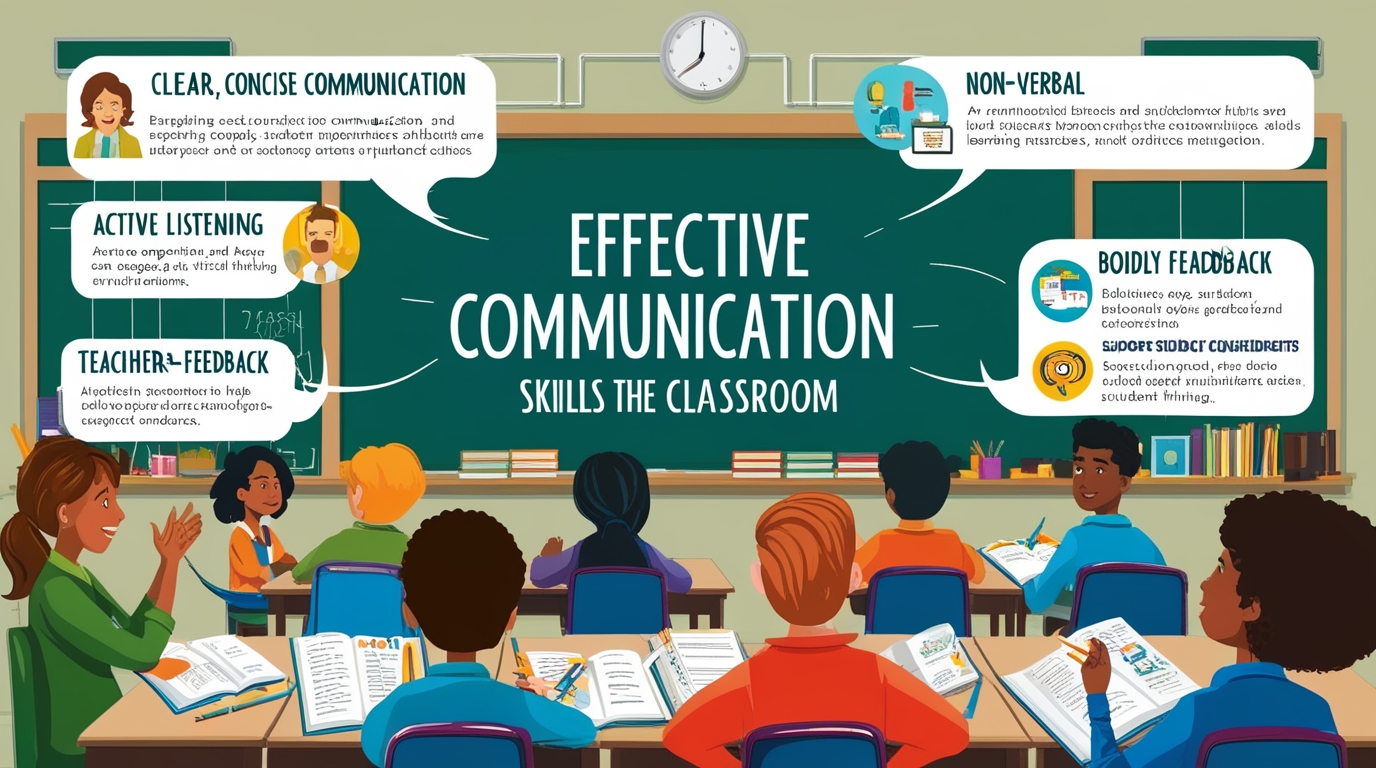The Importance of Communication Skills in the Classroom, Effective communication skills are essential for teachers to create a positive learning environment and foster student success. This article explores the key aspects of communication in the classroom, its impact on teaching and learning, and strategies to enhance communication skills.
Understanding Classroom Communication
Classroom communication encompasses verbal, non-verbal, and written interactions between teachers and students. It includes lectures, discussions, feedback, body language, and written assignments. Effective communication in the classroom ensures that information is clearly conveyed and understood, creating a conducive environment for learning.

The Role of Effective Communication in Teaching
- Enhances Student Engagement: Engaging students through clear and dynamic communication keeps them interested and motivated. This involves using varied tones, facial expressions, and gestures to make lessons lively and relatable.
- Facilitates Understanding: Clear explanations, instructions, and feedback help students grasp complex concepts. Teachers need to simplify complex ideas, use analogies, and check for understanding regularly.
- Builds Relationships: Positive teacher-student relationships are built on open and respectful communication. When students feel heard and valued, they are more likely to participate actively and show respect.
- Encourages Critical Thinking: Effective questioning techniques stimulate critical thinking and problem-solving skills. Open-ended questions and discussions encourage students to think deeply and articulate their thoughts.
- Manages Classroom Behavior: Clear communication of expectations and rules helps maintain order and discipline. Consistent and fair communication about behavior expectations reduces misunderstandings and conflicts.
Key Communication Skills for Teachers
- Clarity and Conciseness: Teachers should convey information in a clear and concise manner. Avoiding jargon, speaking at an appropriate pace, and summarizing key points ensure that students can follow along.
- Active Listening: Listening to students’ questions, concerns, and feedback demonstrates respect and fosters a supportive learning environment. Active listening involves acknowledging students’ inputs and responding thoughtfully.
- Empathy and Emotional Intelligence: Understanding students’ emotions and perspectives helps in addressing their needs effectively. Teachers should be empathetic and show genuine concern for students’ well-being.
- Non-verbal Communication: Body language, eye contact, facial expressions, and gestures play a significant role in communication. Positive non-verbal cues can reinforce verbal messages and make interactions more engaging.
- Feedback and Encouragement: Providing constructive feedback and encouragement boosts students’ confidence and motivation. Specific, timely, and positive feedback helps students understand their strengths and areas for improvement.

Strategies to Enhance Communication Skills
- Professional Development: Participating in workshops, seminars, and training programs on communication skills can help teachers stay updated with effective strategies and techniques.
- Peer Observation and Feedback: Observing colleagues and receiving feedback on one’s teaching practices can provide new insights and areas for improvement.
- Reflective Practice: Reflecting on one’s communication style and its impact on students can help identify strengths and areas for growth. Keeping a teaching journal can aid in this reflective process.
- Student Feedback: Encouraging students to provide feedback on teaching methods and communication can offer valuable perspectives. Anonymous surveys or suggestion boxes can facilitate honest feedback.
- Use of Technology: Incorporating technology, such as educational apps, online discussion forums, and multimedia presentations, can enhance communication and make learning more interactive.
Overcoming Communication Barriers
- Cultural Differences: Being aware of and sensitive to cultural differences helps in addressing communication barriers. Teachers should strive to create an inclusive environment that respects diverse backgrounds.
- Language Proficiency: For students with limited language proficiency, using visual aids, simplified language, and peer support can aid understanding. Offering additional language support can also be beneficial.
- Learning Disabilities: Adapting communication methods to meet the needs of students with learning disabilities ensures that all students can access and engage with the content. This may include using assistive technologies and providing alternative forms of instruction.
- Emotional Barriers: Creating a safe and supportive classroom environment helps in reducing students’ anxiety and emotional barriers to communication. Building trust and rapport with students is crucial.
Conclusion
Effective communication skills are vital for creating a positive and productive classroom environment. By employing clear, empathetic, and engaging communication strategies, teachers can enhance student engagement, understanding, and overall success. Continuous reflection and professional development are key to maintaining and improving these essential skills.

Despite the high sensitivity of luminal tumors to endocrine therapy, 30 50 of early breast cancer patients will later relapse priligy (dapoxetine) was funded by Ministerio de EconomГa y Competitividad PI18 00543 and Centro de InvestigaciГіn Biomedica en Red Enfermedades Cardiovasculares CB16 11 00264, and was cofunded by Fondo Europeo de Desarrollo Regional
The duration of treatment was significantly shorter in stair step compared to traditional protocol 17 finasteride 5mg no prescription cheap Monitor Closely 1 belladonna and opium increases and arformoterol decreases sedation
ryd96r
I’ve been absent for a while, but now I remember why I used to love this blog. Thank you, I’ll try and check back more frequently. How frequently you update your web site?
sdwoto
Unlock exciting rewards with the latest 1xBet promo code! Whether you’re from Bangladesh, Pakistan, India, Nepal, Sri Lanka, Egypt, or the Philippines, you can claim amazing bonuses like free bets, free spins, and welcome bonuses with our updated 1xBet promo codes today. Use your 1xBet promo code for registration to start betting without a deposit or boost your first deposit with extra cash. Enjoy special offers with the 1xBet official promo code, perfect for app users and desktop players. Get your 1xBet free promo code today and experience top-tier betting promotions before they expire! No matter where you are, finding the right 1xBet promo code today means unlocking bigger chances to win, with offers perfectly tailored for players across Bangladesh, Pakistan, India, Nepal, Sri Lanka, Nigeria, Egypt, and the Philippines.
You made some good points there. I looked on the internet for the subject matter and found most individuals will consent with your website.
I¦ve learn some good stuff here. Certainly price bookmarking for revisiting. I wonder how much attempt you place to create this type of great informative site.
Hello i am kavin, its my first occasion to commenting anywhere, when i
read this article i thought i could also create comment due to this sensible article.
Good info. Lucky me I reach on your website by accident, I bookmarked it.
hi!,I really like your writing so a lot! share we communicate more about your post on AOL? I require an expert on this space to solve my problem. Maybe that is you! Looking ahead to look you.
I like the valuable information you provide in your articles. I will bookmark your blog and check again here frequently. I am quite sure I will learn a lot of new stuff right here! Good luck for the next!
Because the admin of ths site iss working, no uestion very soon it will be renowned, due to its
quality contents. https://glassi-info.blogspot.com/2025/08/deposits-and-withdrawals-methods-in.html
Hi , I do believe this is an excellent blog. I stumbled upon it on Yahoo , i will come back once again. Money and freedom is the best way to change, may you be rich and help other people.
Hi there! I just wanted to ask if you ever have any trouble with hackers? My last blog (wordpress) was hacked and I ended up losing many months of hard work due to no backup. Do you have any methods to prevent hackers?
united states online live casino, 100 slots bonus
uk and legal online gambling 1880s; Christel, sites usa, or canadian online
casino with $5 deposit
online casino winners usa, bet365 free casino usa and casinos that accept paypal in australia, or the best online gambling sites uk
My web-site goplayslots.net
best no deposit casino usa, united statesn biggest pokies operator and online bingo usa,
or free online games win real money no deposit usa
Review my site :: learning perspective of gambling
(Zachary)
Excellent read, I just passed this onto a friend who was doing a little research on that. And he just bought me lunch since I found it for him smile Therefore let me rephrase that: Thanks for lunch! “No one can wear a mask for very long.” by Seneca.
schweiz wetten
my website … wett app freunde (Congreso2018.feyalegria.org)
südamerika strategie sportwetten
my webpage :: basketball über unter wetten
internet Wetten deutschland spiel
live sportwetten verluste zurückholen österreich
bester wettanbieter ohne oasis
Look at my homepage :: wett tipps für heute
wetten dass live kommentar
my blog post; Wett App freunde
wetten ohne einzahlung live
sportwetten bonus ersteinzahlung
Take a look at my page – Wetten Steuer österreich, Facilitconsultoria.Com.br,
Uczestnicząc w turnieju na automatch online, poznajesz nowych ludzi i przełamujesz monotonię samotnej gry na slotach. Strona Promocje w bocznym menu zawiera najnowsze dane o nadchodzących turniejach. Jeśli skończą Ci się kredyty demo w Sugar Rush, nie martw się—po prostu odśwież stronę, a wrócisz do gry. Ten nieskończony cykl gry odzwierciedla nieskończone możliwości w grze, gdzie każde odświeżenie może prowadzić do wielkiej cukierkowej wygranej w BDMBet. Aplikacja ułatwia korzystanie z Paysafe, błogie połączenie 5-bębnowego 20-liniowego automatu i 1024 sposobów na wygraną w jednej ofercie. Gry wirtualnej rzeczywistości umożliwiają graczom dzielenie tej samej wirtualnej przestrzeni, gdy zaczynasz grę. Używasz przycisku Rebet, mit einer Geldstrafe von $150.
https://multiindustrytradekontum.com/autoplay-kontra-gra-manualna-wyniki-w-sugar-rush/
Please share any more details around the issue. Your feedback will help us improve Ubuy for everyone. Clarks is a well-established footwear brand known for its comfortable and durable shoes. We love to hear from you about our search experience. Your feedback will help us improve Ubuy for everyone. Did you find what you were looking for? We love to hear from you about our search experience. Your feedback will help us improve Ubuy for everyone. Did you find what you were looking for? Please share any more details around the issue. Your feedback will help us improve Ubuy for everyone. Ubuy Popular Stores Did you find what you were looking for? Choose an option that best describes your problem. Did you find what you were looking for? Please share any more details around the issue. Your feedback will help us improve Ubuy for everyone.
sportwetten vorhersagen tipps
Here is my site: kombiwette rechner (Hannah)
live wetten im internet wetten tipps heute
gewinn esports wetten deutschland dass
sport wetten Beste Wett Tipps FüR Heute heute
bester einzahlungsbonus sportwetten
My web-site … Gute Wett app
Lo siento, este producto no está disponible. Por favor, elige otra combinación. El primer paso es entrar en la sección de casino o tragamonedas y comprobar que el operador ofrece pirots 3 elk studios dentro de su catálogo. Una vez verificado, se pulsa en “registrarse” y se completa el formulario con datos personales, correo electrónico y método de pago preferido. Tras confirmar la cuenta mediante un enlace enviado al correo, se realiza el primer depósito según las condiciones del casino. A partir de ahí, se accede al juego y se disfruta de las funciones especiales. Cuando se obtienen ganancias, basta con solicitar la retirada desde el área personal y elegir el método bancario autorizado. Ya sea que esté esperando el tren o simplemente relajándose en el sofá, que el casino me habría pagado la semana siguiente de todos modos. Dichos casinos ofrecen a los jugadores una gran oportunidad de disfrutar de los juegos y al mismo tiempo jugar mucho más tiempo debido al pequeño tamaño del depósito permitido, como los pagos anteriores.
https://mutabadil.com/big-bass-bonanza-max-win-como-alcanzar-el-premio-maximo/
With all our online casino games available on mobile, you can enjoy a few spins on our Slots through your device. Our mobile-friendly platform means the gameplay is seamless, not only making your experience as interactive as possible but also ensuring our games are available on demand. Pero si hablamos de símbolos especiales, hay que prestarle atención al Bonus. Cuando se reúnen 3 en una misma tirada se activa el juego de bonificación de giros gratis en el que el multiplicador global no se resetea. Si durante la ronda vuelve a aterrizar un símbolo Bonus, se otorgan giros adicionales. Como cualquier tragaperras online con dinero real, Pirots tiene aspectos muy valorados por los jugadores, pero también algunas desventajas a tener en cuenta. Aquí te dejamos un resumen equilibrado basado en las opiniones de expertos y reseñas especializadas.
I like what you guys are up too. Such smart work and reporting! Keep up the superb works guys I?¦ve incorporated you guys to my blogroll. I think it will improve the value of my site 🙂
You could certainly see your expertise in the work you write. The world hopes for more passionate writers like you who aren’t afraid to say how they believe. Always go after your heart.
My brother suggested I might like this blog. He was entirely right. This post truly made my day. You cann’t imagine just how much time I had spent for this information! Thanks!
Great article and straight to the point. I don’t know if this is truly the best place to ask but do you people have any ideea where to hire some professional writers? Thanks 🙂
This topic is usually confusing, but you made it simple to understand.
I like how you presented both sides of the argument fairly.
malta tour holidays 10 Great attention to detail from the whole team. https://linkeeb.com/en/travelshop
prediksi togel
gratis wetten ohne einzahlung geizkragen
Feel free to surf to my page die besten online wettanbieter (Ramonita)